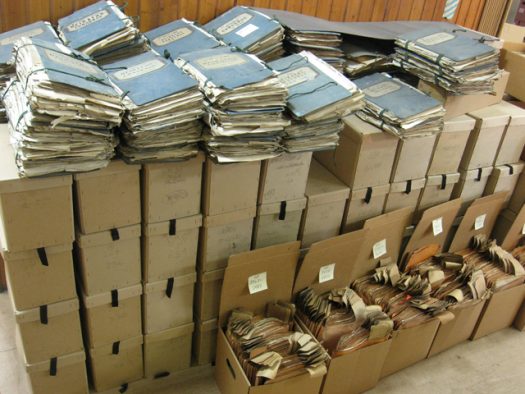
This is Day 4 of the Family History Writing Challenge, 2018
While spending time behind the scenes trying to interpret the documents about Adolf and Bertha Schweitzer that I recently received, I’d like celebrate the remarkable source of those documents: the archive of the Israelitischen Kultusgemeinde (IKG) Wien.
Getting Excited Over Old Documents
I worked for several years in a special collections archive at the University of California San Diego, so I’m a bit of a manuscripts geek to begin with. And I don’t have to explain to the genealogically oriented how exciting it is to find a cache of papers; this is a crowd that went wild when the 1940 Census was put on line.

But several things make some of the IKG archives particularly interesting:
As described on the United States Holocaust Memorial Museum website:
During a routine inspection in 2000 of one of its older buildings, IKG officials found a vacant apartment filled with documents in wooden cabinets and 800 cardboard boxes, covered with decades of dirt, dust, and mold. Closer examination revealed that these materials included a cache of approximately 500,000 Holocaust-era pages of reports, letters, emigration and financial documents, deportation lists, card files, books, photographs, maps, and charts detailing the final years of the once-largest German-speaking Jewish community in Europe and representing a substantial and long-forgotten part of the archive of the Viennese Jewish community.
To recap: The records were lost for 55 years. There are half a million of them.
About the Holocaust Era archives
The majority of the re-found documents were identified as dating from the Nazi era. They include deportation lists, reports, emigration and financial documents, and questionnaires relating to immigration and welfare. In a piece about the archives on NPR in 2007, Paul Shapiro of the U.S. Holocaust Museum says that “for the 118,000 who did escape, these records turned upside down the whole field of Holocaust studies.”
He notes:
It’s often asked why did these Jewish communities go like lambs to the slaughter because we’re often confronted with photographs of people who have already been starved, who have been stripped of their dignity, who are literally at the doors of the gas chambers. In this kind of documentary record, you have a snapshot of the Jewish community of Vienna in its full diversity. You know who the people were. These are not names and people who were lost. You also see the systematic effort of the community to help Jews escape.
This relates back to what I was talking about yesterday, wanting to think of my relatives as they lived, not as they died.
What I received from the IKG
I’ve been to the IKG Archive/Jewish Records Office in Vienna twice; it’s tiny and well protected, as places with treasures should be. The question of why all Jewish-associated facilities in Vienna (and in the U.S.; you can’t just stroll into the Jewish History Museum in Tucson, for example) have such high security needs in contemporary times also relates back to yesterday’s post. Has there been a time or country in history, in fact, when Jewish people could feel entirely secure?
But I digress.
It was wonderful to be able to look over my family documents with the young curator (often the only one of the very small staff who works with the public) and get a detailed translation and interpretation of what I was seeing. Back in Tucson, I don’t have that privilege. But perhaps because the archivist now knows me personally — and I’m pushy — I was able to get several family documents sent to me much more quickly than I could have hoped for.
I received marriage documents for Bertha Kornmehl and an emigration questionnaire filled out by Adolph Schweizer. Both provided a lot of fascinating information, some as yet unfathomable and not only because I don’t know German. Stay tuned.

Leave a Reply